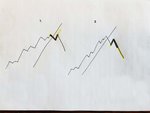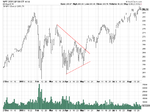Lindsaybev
Junior member
- Messages
- 31
- Likes
- 7
I. I am struggling with the RETRACEMENT.
"Enter on the retracement, a few ticks above the trough of a \/ retracement, and a few ticks below the crest of a /\ retracement." What I am understanding is that a \/ retracement comes when a DEMAND LINE is broken, and a /\ retracement comes when a SUPPLY LINE is broken.
I am starting to write down some "rules" to backtest, but want to make sure I understand clearly. Not sure why it seems difficult to me. But this is what I have written for when a "line is broken":
3. When price definitively breaks a line, EXIT.
When a Demand Line is broken, we are looking for a Short, and enter a few ticks below the crest of a /\ retracement. A break of a Demand Line and a failure to fall says that price is not going to go down. It will either travel sideways or go up...so in this case, watch for a Long.
When a Supply Line is broken, we are looking for a Long, entering a few ticks above the trough of a \/ retracement. A break of a Supply Line with a failure to rally says that price is not going to go up. It will either travel sideways or go down...so in this case, watch for a Short.
If it was trending and takes off in the opposite direction, wait to see if price can make it to the halfway point of the immediately-preceeding run (if it cannot, price is probably still too weak to change the direction and therefore will probably continue in the old direction. If it can exceed it, there is probably a reversal afoot.)
If it was ranging and breaks out of that range, wait for the pullback.
**I enclose a photo that shows two ideas regrading the /\ and \/. I am under the impression that the second picture is the correct interpretation, as I would not know that is was a retracement until it headed back the other direction.
Am I close?
II. The SLAB points out very clearly that we need to take the other time frames (among other things) into consideration, especially where a daily may be ranging, while the hourly may be trending. Are we just using this for possible reversal points but trading the SLA all the way through from these Resistance and Support levels? Or are we only trading the bounces off of and breakouts of these extrmes?
III. I had mentioned earlier that I planned on trading on the daily charts. I said this because (carrying old ideas forward, as you warned about) I was under the impression that it is the daily chart where I will find the longer, intermediate moves. I thought the intermediate moves kept us in for the longer runs, and yet kept us from worrying about the smaller, choppier moves. But I did not yet comprehend that the stops would be further away, opening me up to more risk. So, since I do have the time to work with shorter time frames, I am in the process of re-evaluating this strategy. And I want to thank you for pointing this out.
Lastly, thank you for taking the time to help us all learn. I can't say how invaluable your time is. 🙂
"Enter on the retracement, a few ticks above the trough of a \/ retracement, and a few ticks below the crest of a /\ retracement." What I am understanding is that a \/ retracement comes when a DEMAND LINE is broken, and a /\ retracement comes when a SUPPLY LINE is broken.
I am starting to write down some "rules" to backtest, but want to make sure I understand clearly. Not sure why it seems difficult to me. But this is what I have written for when a "line is broken":
3. When price definitively breaks a line, EXIT.
When a Demand Line is broken, we are looking for a Short, and enter a few ticks below the crest of a /\ retracement. A break of a Demand Line and a failure to fall says that price is not going to go down. It will either travel sideways or go up...so in this case, watch for a Long.
When a Supply Line is broken, we are looking for a Long, entering a few ticks above the trough of a \/ retracement. A break of a Supply Line with a failure to rally says that price is not going to go up. It will either travel sideways or go down...so in this case, watch for a Short.
If it was trending and takes off in the opposite direction, wait to see if price can make it to the halfway point of the immediately-preceeding run (if it cannot, price is probably still too weak to change the direction and therefore will probably continue in the old direction. If it can exceed it, there is probably a reversal afoot.)
If it was ranging and breaks out of that range, wait for the pullback.
**I enclose a photo that shows two ideas regrading the /\ and \/. I am under the impression that the second picture is the correct interpretation, as I would not know that is was a retracement until it headed back the other direction.
Am I close?
II. The SLAB points out very clearly that we need to take the other time frames (among other things) into consideration, especially where a daily may be ranging, while the hourly may be trending. Are we just using this for possible reversal points but trading the SLA all the way through from these Resistance and Support levels? Or are we only trading the bounces off of and breakouts of these extrmes?
III. I had mentioned earlier that I planned on trading on the daily charts. I said this because (carrying old ideas forward, as you warned about) I was under the impression that it is the daily chart where I will find the longer, intermediate moves. I thought the intermediate moves kept us in for the longer runs, and yet kept us from worrying about the smaller, choppier moves. But I did not yet comprehend that the stops would be further away, opening me up to more risk. So, since I do have the time to work with shorter time frames, I am in the process of re-evaluating this strategy. And I want to thank you for pointing this out.
Lastly, thank you for taking the time to help us all learn. I can't say how invaluable your time is. 🙂






